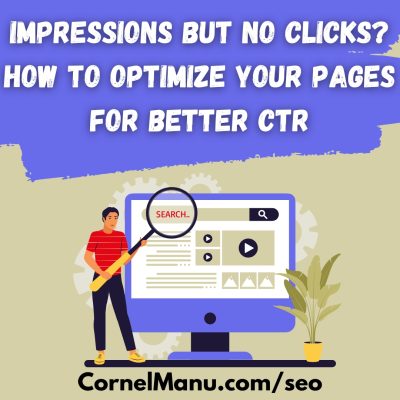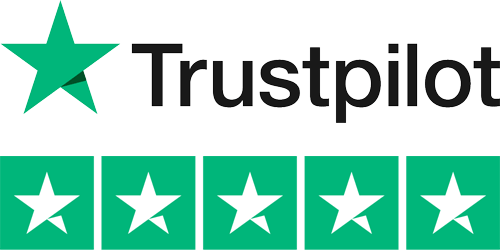Increase your online visibility to boost your sales by up to 30%+ per year. 📈
Get to the top spot in Google without breaking the bank!
Impressions But No Clicks? How to Optimize Your Pages for Better CTR
 When your website is showing up in search results but not getting clicks, it signals a critical issue: while search engines think your content is relevant, users aren’t enticed to click on it.
When your website is showing up in search results but not getting clicks, it signals a critical issue: while search engines think your content is relevant, users aren’t enticed to click on it.
This article dives deep into the steps you can take to turn impressions into clicks by optimizing for click-through rate (CTR).
What Does It Mean to Get Impressions But No Clicks?
An impression occurs every time your page appears in the search engine results page (SERP). However, if users are scrolling past your page without clicking, it could indicate several problems:
- Unattractive Titles or Meta Descriptions: Titles and descriptions may fail to grab attention or align with user intent.
- Mismatched Content: Your page may not satisfy what users are searching for.
- SERP Competition: Rivals in the top spots may have more appealing or better-optimized entries.
- Poor Visual Appearance: Lack of rich results like star ratings or structured data makes your page less noticeable.
Improving CTR is crucial not just for increasing traffic but also for boosting your rankings, as search engines consider user engagement signals like clicks.
Step-by-Step Guide to Boosting CTR
1. Optimize Titles and Meta Descriptions
Your title and meta description are the first things users see in the SERP. They must stand out and compel users to click.
- Analyze Competitors: Look at the top 3 search results for your target keyword. Notice the language, structure, and tone they use.
- Write Action-Oriented Titles: Use power words like “Best,” “Proven,” or “Ultimate Guide.” Incorporate numbers for listicles, e.g., “10 Ways to Optimize CTR.”
- Craft Engaging Meta Descriptions: Highlight benefits or address pain points. Include a call to action, such as “Learn how to boost your traffic today!”
- Use Keywords Strategically: Both titles and meta descriptions should include primary and secondary keywords naturally to reassure users your content matches their intent.
2. Review and Improve Internal Linking
Internal links help distribute authority across your site and guide users to related content.
- Audit Your Pages: Use tools like Screaming Frog or Ahrefs to identify pages with no or few internal links.
- Link Contextually: Add links within the text that provide more value. For example, link “how to optimize for mobile SEO” to a detailed mobile SEO guide.
- Use Descriptive Anchor Texts: Avoid vague text like “click here.” Use specific keywords that describe the linked page.
3. Enhance Keyword Placement
Strategically placed keywords help both search engines and users understand the relevance of your page.
- Include Keywords in Headings: Place primary keywords in H1 and H2 tags for emphasis.
- Sprinkle Keywords Naturally: Use them throughout the text but ensure it reads organically. Avoid keyword stuffing, which can harm readability and rankings.
- Update Outdated Keywords: Use tools like Google Trends or Ubersuggest to check if your target keywords are still relevant and update accordingly.
4. Add Alt Text for Images
Alt text improves accessibility and helps search engines understand image context, which can lead to additional impressions via Google Images.
- Describe Images Accurately: Use concise but descriptive text. For example, “Woman writing on a laptop about SEO strategies.”
- Include Keywords: If relevant, add keywords to your alt text without compromising accuracy.
- Audit Missing Alt Tags: Use tools like Screaming Frog to identify images without alt text and fill in the gaps.
5. Use Schema Markup for Rich Snippets
Schema markup enhances the appearance of your listing in search results, making it more noticeable.
- Add Review Schema: Display star ratings and reviews to attract attention.
- Implement FAQ Schema: Use FAQ schema to provide additional context below your listing.
- Test Your Markup: Use Google’s Rich Results Testing Tool to ensure your schema is correctly implemented and valid.
6. Improve Content Quality
Users click on content that promises—and delivers—value. Enhancing your content to address user intent is essential.
- Expand Thin Content: Add in-depth insights, examples, or case studies to underperforming pages.
- Integrate Visuals: Include relevant images, videos, or infographics to make the content engaging.
- Answer Searcher Questions: Use tools like Answer the Public to identify common user queries and incorporate them into your content.
7. Resubmit URLs to Search Engines
Once you’ve made updates, ensure search engines reflect the changes quickly.
- Google Search Console: Navigate to URL Inspection Tool, paste the updated URL, and click Request Indexing.
- Bing Webmaster Tools: Use the Submit URL feature to prompt Bing to crawl your updated pages.
Tracking and Measuring Results
1. Use a Spreadsheet to Monitor Changes
Tracking your changes ensures you understand what works.
- Log Updates: Record every change, including title rewrites, new meta descriptions, or content updates.
- Track Key Metrics: Monitor impressions, CTR, clicks, and rankings using Google Search Console and analytics tools.
2. Analyze Data and Adjust Strategies
After 2–3 months, evaluate the impact of your changes.
- Look for Patterns: Did click-through rates improve for pages with rewritten meta descriptions?
- A/B Testing: Test alternate headlines or descriptions to see what performs better.
Common Mistakes to Avoid
- Overloading Keywords: Keyword stuffing leads to penalties and lower readability.
- Ignoring Mobile Usability: Ensure your site looks good and functions well on mobile devices.
- Neglecting User Intent: Focus on solving problems or answering questions users care about.
Conclusion
Turning impressions into clicks is a challenge, but with strategic optimization, you can boost your CTR and attract more users to your website. Focus on creating compelling titles and descriptions, enriching content, and leveraging tools like schema markup.
CTR improvement is a gradual process—stay consistent, monitor your results, and adapt based on performance. If you’re looking for expert help to implement and monitor these strategies, consider my SEO packages starting at €500 per month, designed to deliver long-term growth for your business.
Share this:
- Click to share on X (Opens in new window) X
- Click to share on Facebook (Opens in new window) Facebook
- Click to share on LinkedIn (Opens in new window) LinkedIn
- Click to share on Reddit (Opens in new window) Reddit
- Click to share on Tumblr (Opens in new window) Tumblr
- Click to share on Pinterest (Opens in new window) Pinterest


Leave a Comment